ST. LOUIS — Arianne Diño’s fifth-grade class had just finished a math lesson when her students erupted into cheers.
It was time for a “brain break.” An animated frog projected onto the classroom’s white board told students to hop, then slow dance, then “robot.” So, the kids hopped and danced and let their arms dangle as if on a hinge.
Diño laughed along with them. The kids, except for a brief kerfuffle between two boys who accused each other of pushing, seemed genuinely happy to be there. It was a rare scene of a classroom entirely engaged at a time when teachers more than ever struggle to get their kids excited about school.
It took a lot to get to this point.

“I wanted to be a dinosaur because I knew my teacher was going to be one,” said fifth grader Ayden McKinley, 11, of his teacher Arianne Diño as he arrives for class on Halloween, Oct. 31, 2024, at Lemasters Elementary School in the Riverview Gardens School District in north St. Louis County. “She’s the best,” said McKinley. “She tells us every day that she loves us.”
Diño is one of over 100 international teachers — most from the Philippines and Ghana — who are filling positions in St. Louis-area schools no one else wants.
People are also reading…
For many of the teachers, coming to the United States was the fulfillment of a dream, but one, they say, that’s brought challenges.
The teachers have slept on floors, struggled to find food, lived in strangers’ houses and experienced culture shock in their classrooms.
They’ve had to pay the cost of traveling to the U.S. Plus, they have to pay the company that recruited them, Jobs Connect USA, a “placement fee” of $4,000. If they can’t pay the fee upfront, Jobs Connect provides a one-year, $6,000 loan, which they must repay at a rate of $500 a month, teachers said.
Diño, who came to St. Louis from the Philippines, is now in her second year at Lemasters Elementary in the Riverview Gardens School District. She loves her job and calls Jobs Connect “a good agency,” but acknowledges a rocky start.
The cohort of teachers she arrived with lived in a Quality Inn for two weeks and had little access to food.
They “barely ate anything,” Diño said — mostly the free breakfast food and noodles or canned food they brought with them from home.
“It was terrible,” Diño said. “We were crying. We were far away from our family, and this was our experience at first.”
The loans to repay the placement fee also proved burdensome for some.
“By the end of the month, you end up getting nothing,” said one teacher, who asked to be anonymous, citing concerns about possible repercussions from the recruiting firm and his current employer.
The teacher said he’s scraping by to pay Jobs Connect to honor the terms of his contract. He also doesn’t want to sour the Upper Marlboro, Maryland-based business on Ghanaians.
“We don’t want to spoil that opportunity for others,” he said. “We sacrifice for them.”
The shortage
Riverview Gardens in 2023 became the first local district to turn to Jobs Connect. St. Louis Public Schools and Normandy Schools Collaborative followed suit this year.
The three districts are among the lowest-performing in the state, and three of the four lowest-paying districts in St. Louis and St. Louis County on average, the latest state data shows. The average salaries are likely low because the districts employ less-qualified teachers, as all three actually rank in the top 30 of pay for certified teachers with bachelor’s or master’s degrees.
As the national teacher shortage persists, the districts not only have to compete for a dwindling number of applicants, but they’re up against neighbors who, at the highest end, pay their teachers $30,000 more on average. SLPS pays its teachers the least out of the 25 school districts in the city and county with an average teacher salary of $53,877 as of 2022 (the district did, however, approve big raises for teachers earlier this year). Clayton School District, on the other end, pays its teachers an average of $83,620.
SLPS had over 300 certified teacher positions that were either covered by substitute teachers or left vacant, Grow Your Own Coordinator Beth Davey told the district’s Board of Education when she presented Jobs Connect in April. That would account for 20% of the full-time teachers SLPS had in 2023, according to state data.
The state has made multiple efforts to address the educator shortage. It’s lowered the requirements for who can become a substitute teacher. It’s allowed retired teachers to work full-time for up to four years without losing their retirement benefits. Starting next year, baseline teacher salaries will go from $25,000 to $40,000 a year.
The 5,150-student Riverview Gardens district had 98 teacher vacancies when school officials decided to work with Jobs Connect in early 2023. It now employs 50 international teachers and had 80 teacher vacancies as of mid-October.
“We’ve really had to get creative to make sure that we’re putting quality educators in front of our students,” said Travis Ford, assistant superintendent of human resources.

Fifth-grade teacher Arianne Diño, right, arrives at school with other teachers recruited from the Philippines, including Beth Baldo, left, and Zchamer Sindol, center, on Monday, Oct. 30, 2024, at Lemasters Elementary School in the Riverview Gardens School District in unincorporated north St. Louis County. The teachers rely on a carpool because they do not have their own cars, and they live in the same apartment complex.
Most of the international teachers have master’s degrees in education, some even doctorates, Ford said. They undergo professional development provided by the district and are “professionally strong.”
Riverview Gardens started last fall with a cohort of 25 international teachers. The teachers brought with them years of experience. They worked hard. They raised test scores. And the district didn’t have to pay Jobs Connect anything to bring them here. Instead, the teachers bore the costs.
When the Normandy teachers started to arrive, one teacher said they lived in Airbnbs for nine days, with one housing eight individuals and a second 12 people. The district eventually helped them find an apartment.
“From what I know, when those people came here, they didn’t even have a place to stay,” said Ray Cummings, president of Local 420 of the American Federation of Teachers, which represents SLPS teachers and staff. “They had to figure out what to do.”
Very few of the teachers have driver’s licenses, much less the means to purchase vehicles. Some wake up in the early morning hours to catch public transportation. Others rely on their colleagues or bosses to drive them to school and back. Or they spend hundreds of dollars a month on Uber rides, all while they work to pay back the recruiting agency.
Jonathan Tupas, who co-founded Jobs Connect USA with his wife, Alma, said the struggles just come with the immigrant experience. It’s one he had himself when his family moved from the Philippines to the U.S.
“It depends on the person, how they perceive struggle or challenges,” Jonathan Tupas said. “I find it fun. Because that creates character for a person.”
As far as the price of the placement fees and loans, he said Jobs Connect provides its services at a bargain.
“We’re considered as one of the most, if not the most, affordable teacher recruitment agency in the United States,” Tupas said.
An ‘unusual’ practice
Given the demand to fill teacher jobs, some local education leaders were surprised to learn how much the international recruits had to pay.
“My initial reaction is that’s a very unusual practice,” said Mark Jones with the Missouri National Education Association.
“All of us thought that sounded predatory,” said Todd Fuller with the Missouri State Teachers Association.
Christine McDonald, director of communications for the nonprofit Education Plus, said placement fees may be standard practice in other industries, but teachers are so hard to come by here — why would a teacher pay someone to get them a job when schools are so desperate?
Still, there are other firms that assess charges — some more than Jobs Connect. A 2018 report from Searchlight New Mexico found foreign teachers were paying as much as $15,000. Tupas said it’s not uncommon for agencies to charge teachers $25,000 in fees to help them work in America.
But that’s on the high end. Some recruiters, including Intalage, Ites and Global Teaching Partners, only expect teachers to shoulder small costs such as criminal background checks and visa processing fees.
Thirteen states and the Virgin Islands have taken it upon themselves to sponsor J-1 visas, the nonimmigrant visa that allows people to engage in cultural exchange programs, including teaching, studying and research. That’s the same visa program that the St. Louis teachers participate in. The states have mostly partnered with government entities in Spain and France to bring teachers to the U.S. as a means of “promoting multicultural and educational understanding.”
At least two other Missouri school districts have brought international teachers on board, but the districts pay the agency, not the teachers.
St. Joseph Public Schools started hiring international teachers last year but now considers the option a costly last resort. The teachers’ visas require them to return to their home countries in three to five years, and the 38 teachers the district employs cost significantly more than a domestic teacher.
Columbia Public Schools also brought international teachers on board last year and paid a valet service up to $9 per employee per ride to drive them to and from work.
The agency both districts used, International Alliance Group, charges the districts “administrative fees” that are 20% to 25% of each teacher’s annual compensation.

Fifth-grade teacher Arianne Diño helps Zamiyah White, 10, far right, work through a math problem on Thursday, Oct. 24, 2024, at Lemasters Elementary School.
Jobs Connect’s website presents the agency as a low-cost option to onboard qualified teachers through the J-1 cultural exchange visas and prepare students for the “global economy,” emphasis on the “global.”
“We create global leaders by integrating global content into your curriculum,” its website reads. “This integrated exposure to global content leads to students cultivating important global competencies and prepares them to be successful global citizens.”
When his family moved to the U.S. in 2008, Jobs Connect’s Tupas said they struggled too. He “dumpster dived” and sold on Craigslist items he picked up at Goodwill and garage sales.
“If you’re telling me right now that some of the teachers are struggling to get food on the plate or trying to get access to transportation, that’s normal for immigrants,” Tupas said in an interview. “Probably because you’ve been born and raised here in the U.S. you don’t know those struggles.”
But Tupas said he’d prefer the school districts pay for his services and not the teachers; it’s just not a possibility for some of the dozens of school districts Tupas has worked with.
“If they have the budget, that’s well and good, that’s better for us,” Tupas said. “But if they don’t, which is around 80%-85% of the time, the teachers do pay for their expenses.”
Next year, Tupas said Jobs Connect may stop providing teachers loans — a practice he said his agency is one of the last to do.
‘We’re flexible’
Normandy Schools Collaborative has not responded to requests for comment, but at a school board meeting in August, the chief human resources officer said the district had 64 vacancies, and each building would eventually host at least one international teacher.
Normandy hired 26 international teachers this fall, records obtained through a Sunshine request show. It’s unclear if that’s the total number. Director of Communications Christopher Trahan said at an October board meeting the district would receive a second cohort of teachers this fall.
One teacher, Gladys Barangan, said the district welcomed 30 more after the first round.
Barangan, a Filipino who came to Normandy from a school in Cambodia, said she replaced an uncertified teacher who oversaw her school’s entire fifth grade at the start of the school year. The 64 students had to have class in the library.
“When we arrive, that’s the time they split them up,” Barangan said. “There are three classes now in my grade level.”
The international teachers said they don’t get to choose which district they work for or what grade they teach. This will be the first year Barangan, who specializes in early childhood education, will teach higher than the third grade, she said.
Barangan said she and her roommates had to sleep on the floor for the first two days of living in their apartment because they had no way of getting furniture. Barangan said the local Filipino community heard about the teachers’ arrival and brought them home furnishings, cookware, clothes and drove them to stores.

"This is my first year entering a chili," said fifth grade teacher Arianne Diño, left, who discussed the dish with instructional aide Mariah Thomas before voting in a staff chili cook-off on Thursday, Oct. 24, 2024, at Lemasters Elementary School in unincorporated north St. Louis County.
The Philippine Nurses Association of Greater St. Louis has provided the teachers with comforters, blankets, microwaves, kitchenware and more. Two of the nurses had groups of teachers stay in their homes for about a week upon their arrival.
“I don’t want them to be suffering,” the group’s president, Alice Quiao Torregosa, said. “They’re already suffering from when they left their family.”
On a day in October, Barangan’s apartment, a cozy two-bedroom in University City that she shares with three other international teachers, was sparsely furnished.
A small folding table in the middle of the living room supported a jar holding pink hydrangeas. A twin air mattress laid half-deflated in one corner. The teachers had two beds per room.
Rarely, if ever, does Barangan complain. She’s happy to be here, even if the weather is far colder than she’s used to and makes her sick.
“We are teachers and we are flexible,” Barangan said. “That’s what it takes to become a teacher.”
Behind grade level
Diño wanted to show her students the world. She found a way during her first year of teaching, using a carpet.
A giant map of the world displayed on the carpet covers the front area of Diño’s classroom at Lemasters Elementary. It was one of the first things Diño requested for her classroom.
She said she wanted her students to know where she came from. Her students — fourth graders at the time — had never heard of the country. She said they couldn’t point out which continent it belonged to on a map.
“They don’t know Asia,” said Diño, whose name students pronounce as “Dee-no” or “Ms. D.”

Fifth grade teacher Arianne Diño teaches class while standing on a world map rug on Thursday, Oct. 24, 2024, at Lemasters Elementary. The rug was one of the first things Diño requested for her classroom.
International teachers had their work cut out for them when they came to the U.S.
Riverview Gardens, Normandy and SLPS had the three lowest math proficiency rates out of every Missouri school district in 2023 besides the Special School District of St. Louis County. The districts’ proficiency rates in English were in the bottom seven.
At both Diño and Barangan’s schools, 100% of the students qualify for free and reduced lunch, an indicator of poverty. The schools are majority Black and half of the students are chronically absent.
The students’ behavior toward them has also been a struggle, the teachers said. Students talk back, get in physical fights with other students and have trouble focusing.
Barangan said she’s also struggled to communicate with her kids because of the language barrier.
“There are a lot of Filipino teachers here who are really best in their field, but they cannot give their best because of some misbehaved students,” Barangan said.
Last fall, Diño’s class of fourth graders were two to three grade levels behind, with only a couple of her 25 students scoring no higher than “proficient” on state tests.
That changed after a year with Diño, who was a special education teacher in the Philippines. By the end of the school year, she said four of her students scored advanced and several scored proficient. The improvement helped Diño get recognized as Lemasters Elementary’s teacher of the year last year.
Diño said she developed relationships with her students. She empathized with their home lives and got to know their parents. She moved up with them a grade level so she could teach them again this year.
On a recent school day, Diño was teaching her students how to divide with decimals.
Two of Diño’s students only speak Spanish. She crouched next to the desk of a boy, trying to explain division to him by speaking into her phone for Google Translate to play back her words in Spanish. “Do you understand?” she asked. The student said nothing back and stared blankly ahead. Diño was told there wasn’t money for a translator, she said.
Diño went from desk to desk as students worked out problems on a worksheet. “Yes, my angel,” she told one student who raised her hand. “I know you can do this,” she told a student who said he couldn’t figure out a problem.
There’s a clear connection between Diño and her students. Every morning at the start of class, she said she tells her students she loves them and gives them a hug. Outside her classroom door is a sign that reads: “If nobody told you they loved you, remember I do.”
“Working with the kids can be challenging, but it’s not that they can’t learn; it’s not that they can’t do things good,” Diño said. “Our connection right now — it’s a boom. They love me, and I love them so much.”






















